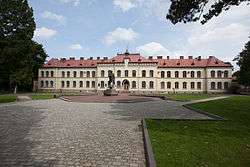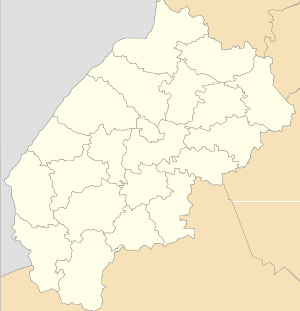Dubliany
Dubliany (Ukrainian: Дубляни; Polish: Dublany) is a city in Zhovkva Raion, Lviv Oblast (region) of Ukraine and a suburb of Lviv (7 km (4.3 mi) away). Population: 10,240 (2013 est.)[1].
Dubliany Дубляни | |
|---|---|
 Agricultural Academy in Dubliany | |
 Flag  Coat of arms | |
 Dubliany  Dubliany | |
| Coordinates: | |
| Country | |
| Oblast | |
| Raion | Zhovkva Raion |
| Population (2013) | |
| • Total | 10,240 |
| Time zone | UTC+2 (EET) |
| • Summer (DST) | UTC+3 (EEST) |
Located in the northern side of Lviv, the city's main landmark is the Agrarian University which was established on 9 January 1856[2] by Halych Economic Society[3] during the Second Polish Republic when Dubliany as a village was part of Lwow Voivodeship as Dublany Agricultural Academy with the only existing Polish-language agricultural academy. In 1919 the academy became part of the Lviv Polytechnic as its agrarian and forestry department.[3] In 1930–33 in Dubliany studied Stepan Bandera and due to the fact, in the university exists Bandera memorial museum.[2]
After World War II Polish ethnic residents of Dubliany were forced to leave the village, and move to the Recovered Territories (see Polish population transfers (1944–46)).[3] Most of them settled in former German village Drachenbrunn near Wroclaw in Silesia.[3] They renamed the village into Dublany (since 1947 - Wojnow, now a district of Wroclaw).
The local Roman Catholic kosciol (Polish church) that was the first known religious building in village built in 1885–1890, since 1990 has been passed to the Ukrainian Autocephalous Orthodox Church.[3] During the Soviet period the temple was used as a sports gym for the agricultural institute.[3] The first Ukrainian Greek Catholic Church, Dormition of the Theotokos, was built in Dubliany only in 1912 and for long period of time local Greek-Catholic population traveled to the neighboring village (about 2 km)[4] of Malekhiv.[3]
In 1910 in Dubliany was built a train station on a railroad Lviv–Kivertsi (Lwow–Kiwerce).
In 1967 the village was granted the status of urban type settlement.[3] In 1978 Dubliany were granted the status of city.[2][3]
Dubliany is the birthplace of Polish painter Adam Werka, and long jumper Edward Czernik.
Among lost landmarks there was a cemetery chapel of Jan Alembek who was a Polonized German apothecary and trades and who for long period was a burgomaster (mayor) of Lwow (Lviv).[3] To Alembek attested the first description of Lviv in Ukrainian Latin Alphabet.[3]
References
- Чисельність наявного населення України [Actual population of Ukraine] (in Ukrainian). State Statistics Service of Ukraine. Retrieved 21 January 2015.
- Dubliany. MistUA.
- Dubliany. Castles and temples of Ukraine.
- Malekhiv, Nesteriv Raion. The History of Cities and Villages of the Ukrainian SSR.
External links
- (in Polish) Dublany (2.) in the Geographical Dictionary of the Kingdom of Poland (1881)